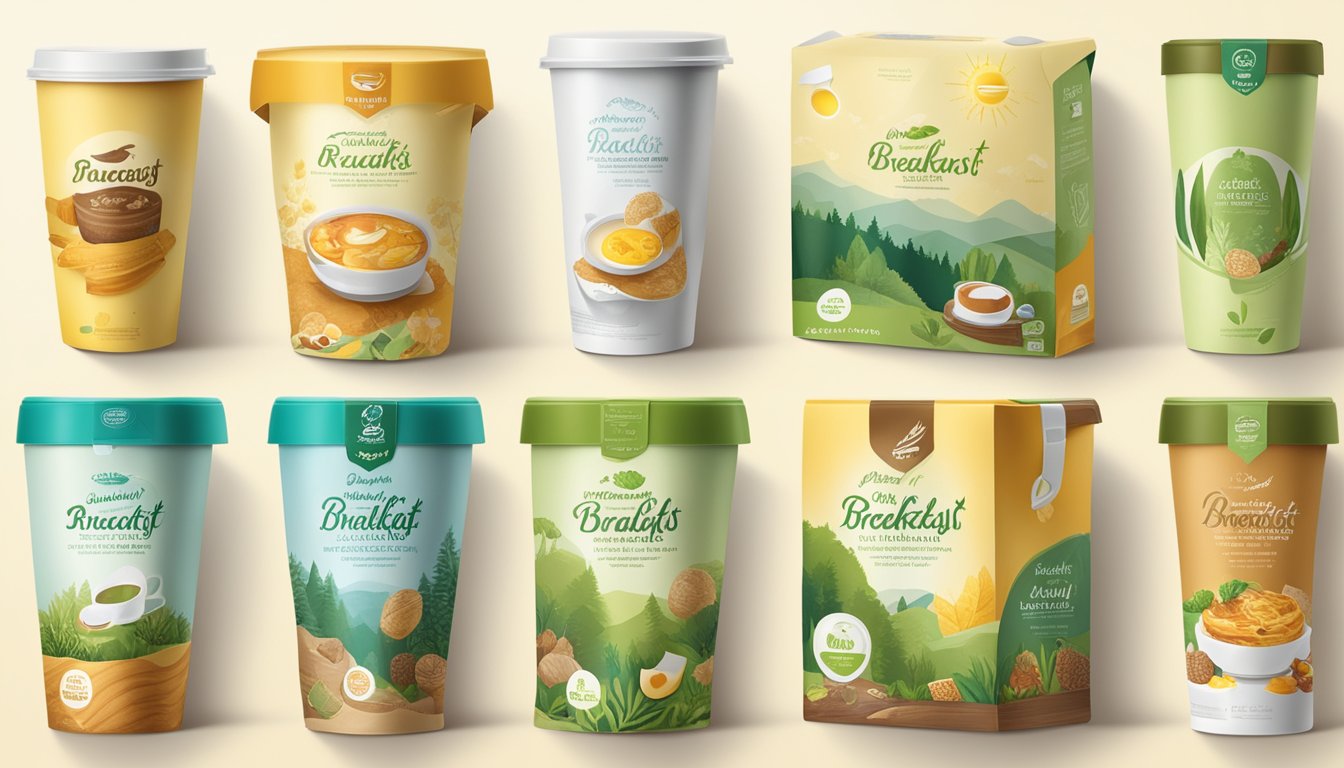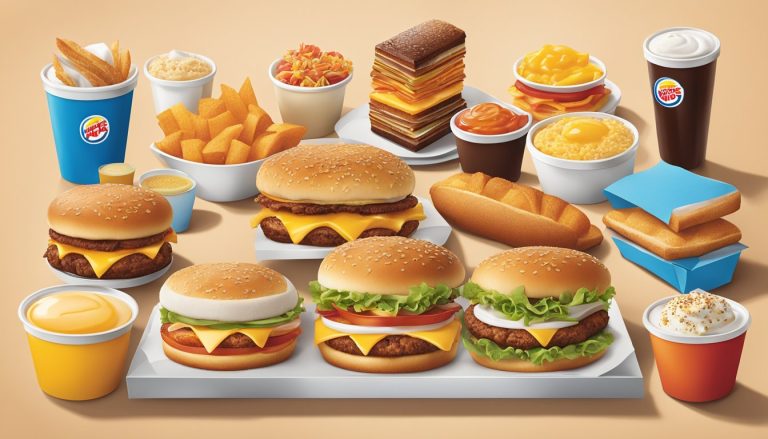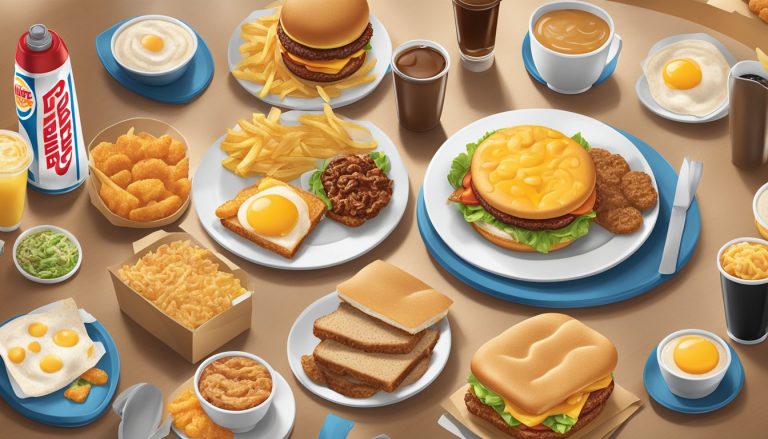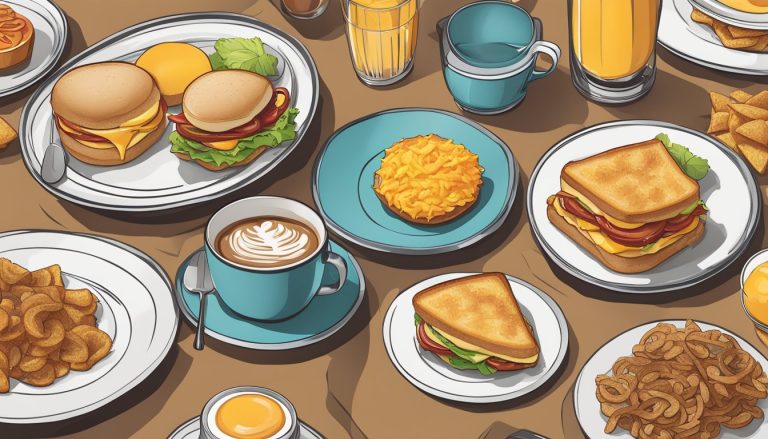Burger King’s breakfast packaging has undergone significant changes in recent years. The fast food giant has shifted its focus towards more sustainable options, responding to growing environmental concerns. This evolution reflects a broader industry trend of reducing waste and adopting eco-friendly materials.
Burger King is transitioning to recyclable and reusable packaging for its breakfast items, aiming to minimize environmental impact. The company has introduced fiber-based wrappers and containers, moving away from traditional plastic packaging. These changes apply to popular breakfast offerings like breakfast sandwiches, hash browns, and coffee cups.
Consumer awareness about packaging waste has pushed Burger King to innovate. The brand is exploring various solutions, including a pilot program for reusable packaging at select locations. This initiative aligns with Burger King’s commitment to sustainability and its efforts to appeal to environmentally conscious customers.
Brand and Industry Context

Burger King has established itself as a major player in the fast food landscape. The company’s brand identity has evolved over time, adapting to changing consumer preferences and market trends. Labor issues remain a significant factor in the restaurant business.
BK’s Position in the Fast Food Restaurant Industry
Burger King ranks among the top fast food chains globally. The brand holds a strong market share, particularly in the burger segment. BK competes directly with other major chains like McDonald’s and Wendy’s. The company operates thousands of locations across numerous countries.
BK differentiates itself through menu offerings like the Whopper and flame-grilled patties. The chain has expanded its menu to include breakfast items, salads, and plant-based options. This diversification aims to appeal to a broader customer base.
Franchising forms a key part of BK’s business model. Most Burger King restaurants are operated by independent franchisees rather than the parent company.
Evolution of Brand Identity
Burger King’s brand identity has undergone several transformations since its founding in 1954. The company’s logo, restaurant designs, and marketing campaigns have been updated periodically to stay relevant.
In recent years, BK has embraced a more modern aesthetic. The brand has adopted a simplified logo and cleaner restaurant layouts. Marketing efforts have become more digitally focused, leveraging social media and mobile apps.
Sustainability has emerged as a new aspect of BK’s brand identity. The company has introduced initiatives like reusable packaging and plant-based menu items. These efforts aim to appeal to environmentally conscious consumers.
BK’s “Have It Your Way” slogan emphasizes customization and customer choice. This positioning helps differentiate the brand from competitors.
Labor and the Restaurant Business
Labor issues significantly impact Burger King and the broader restaurant industry. Employee turnover rates in fast food tend to be high, creating ongoing staffing challenges.
Wage debates have become a focal point. Many fast food workers advocate for higher pay and improved benefits. Some cities and states have implemented minimum wage increases affecting restaurant operations.
Training and retention programs are crucial for BK and other chains. Developing skilled employees helps maintain service quality and operational efficiency.
Technology adoption, like self-ordering kiosks, has begun to reshape restaurant labor needs. These innovations may alter staffing requirements in the future.
Labor costs represent a substantial portion of restaurant expenses. Balancing fair compensation with profitability remains an ongoing challenge for BK and its competitors.
Historical Progression of BK’s Breakfast Menu

Burger King’s breakfast offerings have evolved significantly since their introduction. The menu has expanded from simple sandwiches to diverse options, including iconic items and innovative concepts.
Introduction of the Breakfast Menu
Burger King entered the breakfast market in 1979. The initial menu was limited, focusing on basic breakfast staples. Early offerings included eggs, bacon, and toast combinations.
In 1983, BK introduced the Croissan’wich. This sandwich, a portmanteau of croissant and sandwich, became a signature item. It featured eggs, cheese, and a choice of ham, bacon, or sausage on a flaky croissant.
The Croissan’wich helped differentiate Burger King’s breakfast from competitors. It provided a more upscale option compared to traditional breakfast sandwiches.
From Croissan’wich to Enormous Omelet Sandwich
Building on the Croissan’wich’s success, BK expanded its breakfast lineup. New variations of the sandwich were added, including double meat options.
In 2005, Burger King launched the Enormous Omelet Sandwich. This hefty offering contained:
- Two eggs
- Two slices of American cheese
- Three strips of bacon
- A sausage patty
The Enormous Omelet Sandwich pushed the boundaries of breakfast sandwiches. It catered to customers seeking larger, more indulgent options.
Expansion to Burgers for Breakfast
Burger King took a bold step by introducing burgers to its breakfast menu. This move blurred the lines between traditional breakfast and lunch offerings.
The Whopper, BK’s signature burger, became available during breakfast hours at select locations. This decision allowed customers to enjoy their favorite sandwich any time of day.
Other breakfast innovations included:
- Breakfast platters with pancakes and hash browns
- Breakfast burritos
- French toast sticks
These additions provided more variety and appealed to different tastes and preferences.
Environmental Impacts of Packaging

Food packaging design and consumer expectations play crucial roles in the environmental impact of breakfast packaging. The materials used and sustainability efforts influence the overall ecological footprint of packaging products.
Packaging Design and Sustainability
Packaging design directly affects environmental outcomes. Non-biodegradable materials contribute to pollution concerns, with food packaging being a major sector in the synthetic plastic market. Paper, glass, and plastics are used globally for packaging purposes.
Steel packaging requires high-temperature smelting, though iron is abundant. Life cycle assessments (LCA) are increasingly applied to evaluate the environmental impact of various packaging types. These assessments consider raw material extraction, manufacturing processes, and end-of-life disposal.
Some packaging designs aim to reduce food waste, aligning with sustainable development goals. This aspect is often overlooked when assessing packaging impacts.
Consumer Expectations on Eco-Friendly Packaging
Consumers increasingly demand eco-friendly packaging options. This shift in expectations drives companies to explore sustainable alternatives. Biodegradable materials and recycled content are becoming more common in food packaging.
Consumers look for clear labeling on packaging recyclability and disposal instructions. Companies respond by improving packaging designs and using more environmentally friendly materials. Some brands highlight their sustainability efforts on packaging to appeal to eco-conscious customers.
Despite these efforts, single-use packaging remains prevalent. Food and packaging materials constitute nearly half of all municipal solid waste in the US. Recycling rates for packaging materials vary widely, with many items ending up in landfills or as litter.
Product Diversity and Packaging Requirements

Burger King’s diverse menu necessitates a range of packaging solutions to accommodate different food items. The packaging must balance functionality, product protection, and environmental considerations.
Packaging Variants for Diverse Menu Items
Burger King employs various packaging types for its menu offerings. Hamburgers and Whoppers come in paper wraps or cardboard boxes, providing insulation and preventing mess. French fries are served in paper sleeves or cartons, allowing for easy portability and oil absorption. Soft drinks and milkshakes use plastic cups with lids and straws.
Desserts like sundaes and ice cream cones have specialized containers to maintain temperature and prevent melting. Chicken and fish items often use similar packaging to burgers, with additional consideration for grease resistance.
Special Packaging for Iconic Products
The Whopper, Burger King’s flagship product, receives special attention in its packaging design. Its distinctive box features a larger size and reinforced structure to support the burger’s weight and toppings. The packaging often includes branding elements that highlight the Whopper’s iconic status.
Other popular items like chicken fries come in unique containers designed for easy snacking on-the-go. Salads are packaged in clear plastic bowls with separate compartments for toppings and dressings, ensuring freshness and allowing customers to see the ingredients.
Collaborations and Co-Branding

Burger King has forged strategic partnerships with major beverage and condiment brands to enhance its breakfast offerings. These collaborations have led to innovative cross-promotional campaigns and co-branded packaging designs.
Partnerships with Coca-Cola and Heinz
Burger King’s long-standing partnership with Coca-Cola ensures a steady supply of soft drinks for its breakfast menu. The fast-food chain prominently features Coca-Cola branding on its cups and fountain drink stations. This collaboration extends to promotional tie-ins, with special edition cups and collectible designs.
Heinz ketchup packets are a staple at Burger King restaurants, including during breakfast hours. The partnership includes co-branded ketchup dispensers and packets featuring both companies’ logos. Burger King has also worked with Heinz to develop specialty sauces for breakfast sandwiches.
Cross-Promotional Branding Efforts
Burger King engages in cross-promotional campaigns to boost breakfast sales. The company has collaborated with popular cereal brands to create limited-time menu items. These partnerships result in unique breakfast offerings that blend familiar cereal flavors with Burger King’s existing menu.
Co-branded packaging for these special items features both Burger King and partner logos. These collaborations often include joint advertising campaigns across various media channels. Social media plays a crucial role in promoting these limited-time offers, generating buzz and driving customer interest.
Burger King has also partnered with coffee brands to enhance its breakfast beverage lineup. These collaborations lead to co-branded coffee cups and promotional materials in stores.
The Adult Market: Specialty and Upscale Offerings

Burger King has expanded its menu to cater to adult tastes with premium sandwiches and higher-quality ingredients. These offerings aim to attract a more discerning customer base and compete with fast-casual restaurants.
Exploring BK’s Specialty Sandwich Lines
Burger King introduced several specialty sandwiches to appeal to adult palates. The Big King stands out as a signature item, featuring two flame-grilled beef patties, special sauce, and a three-piece bun. Initially tested as the Double Supreme in 1996, it was later refined to its current form.
The King Supreme offers a more upscale twist on the classic hamburger. It includes a quarter-pound beef patty, crisp lettuce, fresh tomatoes, and mayo on a toasted sesame seed bun.
BK also experimented with limited-time offerings to keep the menu fresh and exciting for adult customers. These often feature premium ingredients or unique flavor combinations.
Catering to a Mature Palate with the BK Stacker and Other Options
The BK Stacker series targets adults seeking heartier meals. This customizable sandwich allows customers to choose from one to four beef patties, each topped with bacon and cheese.
BK’s specialty lines often incorporate higher-quality ingredients. Angus beef patties, artisanal buns, and gourmet toppings feature prominently in these upscale offerings.
To complement these sandwiches, Burger King expanded its side dish options. Premium salads, fruit smoothies, and specialty coffees provide healthier or more sophisticated alternatives to traditional fast food fare.
The company also revamped its breakfast menu with items like croissant sandwiches and breakfast burritos to attract the morning commuter crowd.
Ownership and Influence

Burger King’s ownership structure and major investors play a crucial role in shaping the company’s branding, packaging choices, and product offerings. Two key players have significantly influenced BK’s direction in recent years.
Roles of TPG Capital and 3G Capital in BK’s Branding
TPG Capital acquired Burger King in 2002, initiating a period of brand revitalization. The firm implemented new marketing strategies and menu innovations to boost BK’s appeal.
In 2010, 3G Capital purchased Burger King for $3.26 billion. This Brazilian investment firm brought a focus on cost-cutting and efficiency improvements. 3G Capital’s influence led to streamlined operations and a renewed emphasis on the core menu items.
The firm also pushed for global expansion, particularly in emerging markets. This growth strategy impacted BK’s approach to packaging and product localization.
Influence on Packaging Choices and Product Offering
3G Capital’s cost-conscious approach has influenced Burger King’s packaging decisions. The firm encouraged the use of more economical materials while balancing environmental concerns.
This led to the introduction of lighter-weight packaging and the exploration of sustainable alternatives. BK began testing green packaging options, including recyclable and compostable materials.
The investor’s influence extended to product offerings as well. 3G Capital pushed for menu simplification, focusing on high-margin items. This strategy affected packaging needs, as fewer distinct package types were required.
The firm also emphasized data-driven decision-making, leading to more targeted regional menu variations. This approach necessitated flexible packaging solutions to accommodate diverse product lines across different markets.
Competition and Market Differentiation

Burger King’s breakfast offerings face stiff competition in a crowded market. The fast food giant employs strategic packaging and product innovation to maintain its edge.
BK’s Competitive Edge in Breakfast Offerings
Burger King’s breakfast menu boasts a variety of options to cater to diverse tastes. The chain’s breakfast sandwiches, including the Croissan’wich and Egg-normous Burrito, come in eye-catching packaging designed to stand out on crowded counters.
BK’s breakfast products often feature bold colors and prominent branding to grab customers’ attention. The company uses packaging to highlight key selling points like “freshly prepared” or “made to order” to differentiate from competitors.
To compete with healthier alternatives, BK has introduced lighter options like oatmeal and fruit cups in transparent containers, showcasing the fresh ingredients inside.
Analysis of Breakfast Market Presence
Burger King’s breakfast market share faces challenges from established players like McDonald’s and emerging fast-casual chains. BK has responded by extending breakfast hours and offering all-day breakfast items in some locations.
The chain leverages its flame-grilled heritage in breakfast offerings, incorporating smoky flavors into items like the Breakfast Bacon King sandwich. This unique taste profile sets BK apart from competitors relying on griddles or ovens.
BK’s breakfast packaging often includes convenient features like easy-open tabs or built-in utensils to appeal to on-the-go customers. These practical design elements aim to enhance the eating experience and build brand loyalty in a competitive market.




